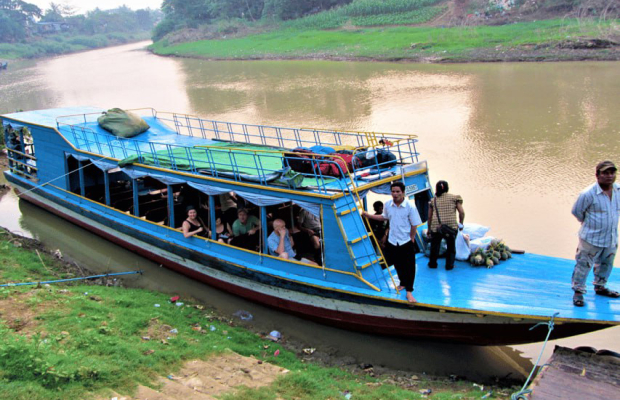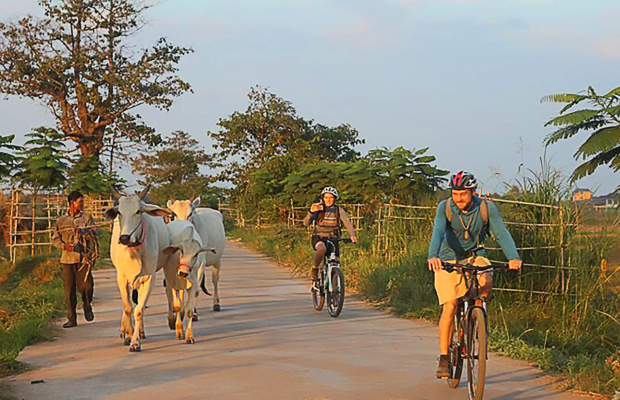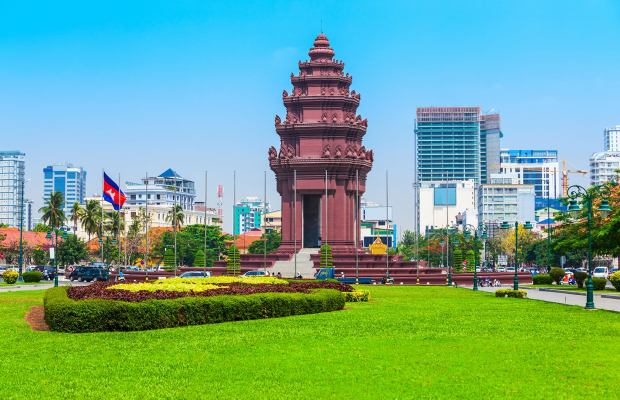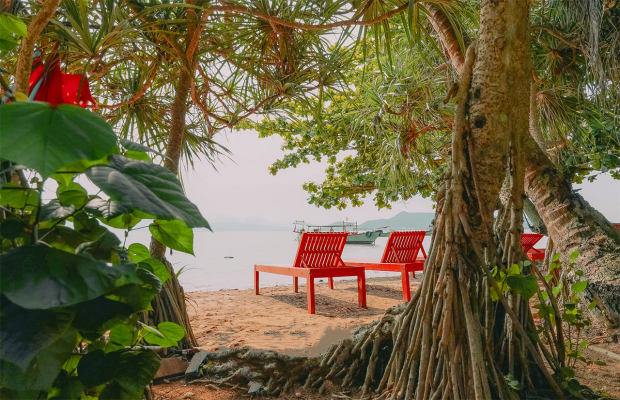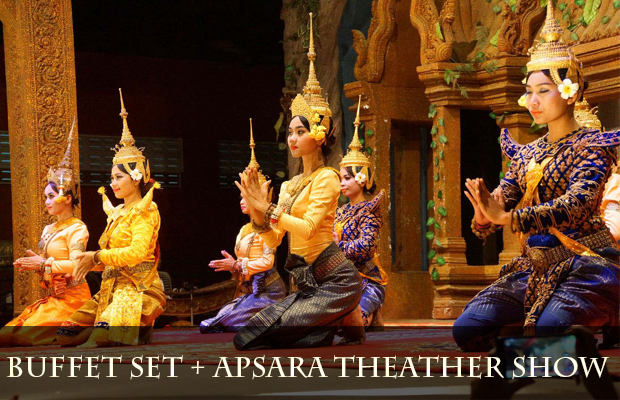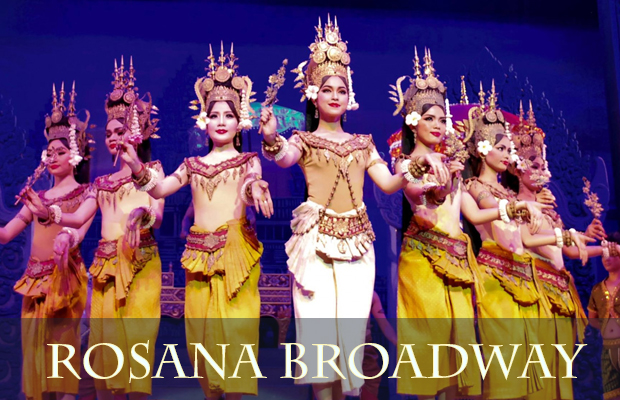Cambodia Information
Cambodia Tradition & Culture
The culture of Cambodia has had a rich and varied history dating back many centuries, and has been heavily influenced by India. Throughout Cambodia's long history, a major source of inspiration was from religion. Throughout nearly two millennia, Cambodians developed a unique Khmer belief from the syncreticism of indigenous animistic beliefs and the Indian religions of Buddhism and Hinduism. Indian culture and civilization, including its language and arts reached mainland Southeast Asia around the 1st century AD.
The History
The golden age of Cambodia was between the 9th and 14th century, during the Angkor period, during which it was a powerful and prosperous empire that flourished and dominated almost all of inland Southeast Asia. However, Angkor would eventually collapse after much in-fighting between royalty and constant warring with its increasingly powerful neighbors, notably Siam and Dai Viet. Many temples from this period however, like Bayon and Angkor Wat still remain today, scattered throughout Thailand, Cambodia, Laos, and Vietnam as a reminder of the grandeur of Khmer arts and culture. Cambodia's unparalleled achievements in art, architectures, music, and dance during this period have had a great influence on many neighboring kingdoms, namely Thailand and Laos. The effect of Angkorian culture can still be seen today in those countries, as they share many close characteristics with current-day Cambodia.
Architecture and housing
The Angkorian architects and sculptors created temples that mapped the cosmic world in stone. Khmer decorations drew inspiration from religion, and mythical creatures from Hinduism and Buddhism were carved on walls. Temples were built in accordance to the rule of ancient Khmer architecture that dictated that a basic temple layout include a central shrine, a courtyard, an enclosing wall, and a moat. Khmer motifs use many creatures from Buddhist and Hindu mythology, like the Royal Palace in Phnom Penh, use motifs such as the garuda, a mythical bird in Hinduism. The architecture of Cambodia developed in stages under the Khmer empire from the 9th to the 15th century, preserved in many buildings of the Angkor temple. The remains of secular architecture from this time are rare, as only religious buildings were made of stone. The architecture of the Angkor period used specific structural features and styles, which are one of the main methods used to date the temples, along with inscriptions.
In modern rural Cambodia, the nuclear family typically lives in a rectangular house that may vary in size from four by six meters to six by ten meters. It is constructed of a wooden frame with gabled thatch roof and walls of woven bamboo. Khmer houses are typically raised as much as three meters on stilts for protection from annual floods. Two ladders or wooden staircases provide access to the house. The steep thatch roof overhanging the house walls protects the interior from rain. Typically a house contains three rooms separated by partitions of woven bamboo. The front room serves as a living room used to receive visitors, the next room is the parents' bedroom, and the third is for unmarried daughters. Sons sleep anywhere they can find space. Family members and neighbors work together to build the house, and a house-raising ceremony is held upon its completion. The houses of poorer persons may contain only a single large room. Food is prepared in a separate kitchen located near the house but usually behind it. Toilet facilities consist of simple pits in the ground, located away from the house, that are covered up when filled. Any livestock is kept below the house. Chinese and Vietnamese houses in Cambodian towns and villages are typically built directly on the ground and have earthen, cement, or tile floors, depending upon the economic status of the owner. Urban housing and commercial buildings may be of brick, masonry, or wood
Religion in Cambodia
Cambodia is predominantly Buddhist with 90% of the population being Theravada Buddhist, 1% Christian and the majority of the remaining population follow Islam, atheism, or animism.
Buddhist nun at Angkor Wat, Siem Reap, Cambodia.
Buddhism has existed in Cambodia since at least the 5th century CE Theravada Buddhism has been the Cambodian state religion since the 13th century CE (excepting the Khmer Rouge period), and is currently estimated to be the faith of 90% of the population.
Buddhist monks at Angkor Wat. Buddhism is the official religion in all of Cambodia.
Islam is the religion of a majority of the Cham (also called Khmer Islam) and Malay minorities in Cambodia. According to Po Dharma, there were 150,000 to 200,000 Muslims in Cambodia as late as 1975. Persecution under the Khmer Rouge eroded their numbers, however, and by the late 1980s they probably had not regained their former strength. All of the Cham Muslims are Sunnis of the Shafi'i school. Po Dharma divides the Muslim Cham in Cambodia into a traditionalist branch and an orthodox branch.
Christianity was introduced into Cambodia by Roman Catholic missionaries in 1660. However, it made little headway at first, particularly among Buddhists. In 1972 there were probably about 20,000 Christians in Cambodia, most of whom were Roman Catholics. According to Vatican statistics, in 1953, members of the Roman Catholic Church in Cambodia numbered 120,000, making it, at that time, the second largest religion in the country. In April 1970, just before repatriation, estimates indicate that about 50,000 Catholics were Vietnamese. Many of the Catholics remaining in Cambodia in 1972 were Europeans—chiefly French. American Protestant missionary activity increased in Cambodia, especially among some of the hill tribes and among the Cham, after the establishment of the Khmer Republic. The 1962 census, which reported 2,000 Protestants in Cambodia, remains the most recent statistic for the group. Observers reported that in 1980 there were more registered Khmer Christians among the refugees in camps in Thailand than in all of Cambodia before 1970. Kiernan notes that, until June 1980, five weekly Protestant services were held in Phnom Penh by a Khmer pastor, but that they had been reduced to a single weekly service after police harassment. There are around 20,000 Catholics in Cambodia which represents only 0.15% of the total population. There are no dioceses, but there are three territorial jurisdictions - one Apostolic Vicariate and two Apostolic Prefectures.
Way of Life
+ Birth and death rituals
The birth of a child is a happy event for the family. According to traditional beliefs, however, confinement and childbirth expose the family, and especially the mother and the child to harm from the spirit world. A woman who dies in childbirth—crosses the river (chhlong tonle) in Khmer is believed to become an evil spirit. In traditional Khmer society, a pregnant woman respects a number of food taboos and avoids certain situations. These traditions remain in practice in rural Cambodia, but they have become weakened in urban areas.
Death is not viewed with the great outpouring of grief common to Western society; it is viewed as the end of one life and as the beginning of another life that one hopes will be better. Buddhist Khmer usually are cremated, and their ashes are deposited in a stupa in the temple compound. A corpse is washed, dressed, and placed in a coffin, which may be decorated with flowers and with a photograph of the deceased. White pennant-shaped flags, called "white crocodile flags," outside a house indicate that someone in that household has died. A funeral procession consisting of an achar, Buddhist monks, members of the family, and other mourners accompanies the coffin to the crematorium. The spouse and the children show mourning by shaving their heads and by wearing white clothing. Relics such as teeth or pieces of bone are prized by the survivors, and they are often worn on gold chains as amulets.[4] If the child is always ill, his or her parents can go and change the name of child.
+ Childhood and adolescence
A Cambodian child may be nursed until he or she is between two and four years of age. Up to the age of three or four, the child is given considerable physical affection and freedom. Children around five years of age also may be expected to help look after younger siblings. Children's games emphasize socialization or skill rather than winning and losing.[4]
Most children begin school when they are seven or eight. By the time they reach this age, they are familiar with the society's norms of politeness, obedience, and respect toward their elders and toward Buddhist monks. The father at this time begins his permanent retreat into a relatively remote, authoritarian role. By age ten, a girl is expected to help her mother in basic household tasks; a boy knows how to care for the family's livestock and can do farm work under the supervision of older males. Adolescent children usually play with members of the same sex. During his teens, a boy may become a temple servant and go on to serve a time as a novice monk, which is a great honor for the parents.
In precommunist days, parents exerted complete authority over their children until the children were married, and the parents continued to maintain some control well into the marriage. Age difference is strictly recognized with polite vocabulary and special generational terms for "you".
+ Courtship, marriage, and divorce
In Cambodia, premarital sex is deplored. The choice of a spouse is a complex one for the young male, and it may involve not only his parents and his friends, as well as those of the young woman, but also a matchmaker. In theory, a girl may veto the spouse her parents have chosen. Courtship patterns differ between rural and urban Khmer; romantic love is a notion that exists to a much greater extent in larger cities. A man usually marries between the ages of nineteen and twenty-five, a girl between the ages of sixteen and twenty-two. After a spouse has been selected, each family investigates the other to make sure its child is marrying into a good family. In rural areas, there is a form of bride-service; that is, the young man may take a vow to serve his prospective father-in-law for a period of time.
The traditional wedding is a long and colorful affair. Formerly it lasted three days, but in the 1980s it more commonly lasted a day and a half. Buddhist priests offer a short sermon and recite prayers of blessing. Parts of the ceremony involve ritual hair cutting, tying cotton threads soaked in holy water around the bride's and groom's wrists, and passing a candle around a circle of happily married and respected couples to bless the union. After the wedding, a banquet is held. Newlyweds traditionally move in with the wife's parents and may live with them up to a year, until they can build a new house nearby.
Divorce is legal and relatively easy to obtain, but not common. Divorced persons are viewed with some disapproval. Each spouse retains whatever property he or she brought into the marriage, and jointly-acquired property is divided equally. Divorced persons may remarry, but the woman must wait ten months. Custody of minor children is usually given to the mother, and both parents continue to have an obligation to contribute financially toward the rearing and education of the child. The divorced male doesn't have a waiting period before he can re-marry.
+ Social Organization
Khmer culture is very hierarchical. The greater a person's age, the greater the level of respect that must be granted to them. Cambodians are addressed with a hierarchical title corresponding to their seniority before the name. When a married couple becomes too old to support themselves, they may invite the youngest child's family to move in and to take over running the household. At this stage in their lives, they enjoy a position of high status.
The individual Khmer is surrounded by a small inner circle of family and friends who constitute his or her closest associates, those he would approach first for help. The nuclear family, consisting of a husband and a wife and their unmarried children, is the most important kin group. Within this unit are the strongest emotional ties, the assurance of aid in the event of trouble, economic cooperation in labor, sharing of produce and income, and contribution as a unit to ceremonial obligations. In rural communities, neighbors—who are often also kin—may be important, too. Fictive child-parent, sibling, and close friend relationships Cambodia transcend kinship boundaries and serve to strengthen interpersonal and interfamily ties. Beyond this close circle are more distant relatives and casual friends. In rural Cambodia, the strongest ties a Khmer may develop—besides those to the nuclear family and to close friends—are those to other members of the local community. A strong feeling of pride—for the village, for the district, and province—usually characterizes Cambodian community life.
Legally, the husband is the head of the Khmer family, but the wife has considerable authority, especially in family economics. The husband is responsible for providing shelter and food for his family; the wife is generally in charge of the family budget, and she serves as the major ethical and religious model for the children, especially the daughters. Both husbands and wives are responsible for domestic economic tasks.
+ Customs
In Khmer culture a person's head is believed to contain the person's soul--therefore making it taboo to touch or point your feet at it. It is also considered to be extremely disrespectful to point or sleep with your feet pointing at a person, as the feet are the lowest part of the body and are considered to be impure.
When greeting people or to show respect in Cambodia people do the "sampeah" gesture, identical to the Indian namaste and Thai wai.
Customary Cambodian teachings include: that if a person does not wake up before sunrise he is lazy; you have to tell your parents or elders where you are going and what time you are coming back home; close doors gently, otherwise you have a bad temper; sit with your legs straight down and not crossed (crossing your legs shows that you are an impolite person); and always let other people talk more than you.
In Cambodia it is not polite to have eye contact with someone who is older or someone who is considered a superior.
Khmer Clothing
Clothing in Cambodia is one of the most important aspects of the culture. Cambodian fashion is divided by the people's differing castes and social classes. Cambodians traditionally wear a checkered scarf called a "Krama". The "krama" is what distinctly separates the Khmer (Cambodians) from their neighbors the Thai, the Vietnamese, and the Laotians. The scarf is used for many purposes including for style, protection from the sun, an aid (for your feet) when climbing trees, a hammock for infants, a towel, or as a "sarong". A "krama" can also be easily shaped into a small child's doll for play. Under the Khmer Rouge, krama of various patterns were part of standard clothing.
Khmer Cuisine
Khmer cuisine is similar to that of its Southeast Asian neighbors. It shares many similarities with Thai cuisine, Vietnamese cuisine and Teochew cuisine. Cambodian cuisine also uses fish sauce widely in soups, stir-fried cuisine, and as dippings. The Chinese legacy of Stir frying can be noted in the use of many variations of rice noodles; while curry dishes known as kari (in Khmer) that employ dried spices such as star anise, cardamom, cinnamon, nutmeg and fennel were borrowed from the Indians and given a distinctive Cambodian twist with the addition of local ingredients like lemongrass, garlic, kaffir lime leaves, shallots and galangal. Pork broth rice noodle soup known simply as ka tieu is one of Cambodia's popular dish. Also, Banh Chao is the Khmer version of the Vietnamese Bánh xèo.
Khmer cuisine is noted for the use of prahok , a type of fermented fish paste, in many dishes as a distinctive flavoring. When prahok is not used, it is likely to be kap? Instead, a kind of fermented shrimp paste. Coconut milk is the main ingredient of many Khmer curries and desserts. In Cambodia there is regular aromatic rice and glutinous or sticky rice. The latter is used more in dessert dishes with fruits such as durian. Almost every meal is eaten with a bowl of rice. Typically, Cambodians eat their meals with at least three or four separate dishes. Each individual dish will usually be one of either sweet, sour, salty or bitter. Chili is usually left up to the individual to add themselves. In this way Cambodians ensure that they get a bit of every flavor to satisfy their palates.
Otherwise,Cuisine of Cambodians also become unique depend on some area of different ethnics. In Kampot and Kep, famous for its cuisine known Kampot Pepper Crab or Kdab Cha Mrin Kyai in Khmer. With its name Kampot Pepper crab, this cuisine is mostly cooking with kampot famous crap fried with the pepper from pepper field in the area. While in Pailin, Mee Kola is was born in that place, create by Kula people who is one of ethnic groups in Cambodia.In southern Cambodia, most of Vietnamese cuisine had been found especially Bánh tráng which is so famous dish in southern Cambodia but just few people from Central, had ever eat this meals. Look forward to the area between Siem Reap and Kampong Thom, a village with full of Chinese Cambodians. A lot of delicious dishes from China in Khmer version explored for the guest in family as well as its urban restaurants.








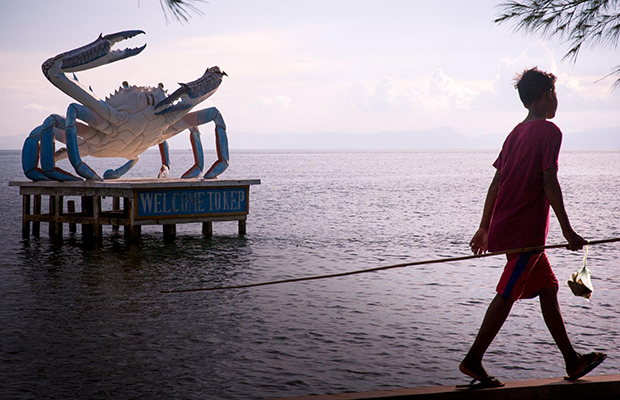

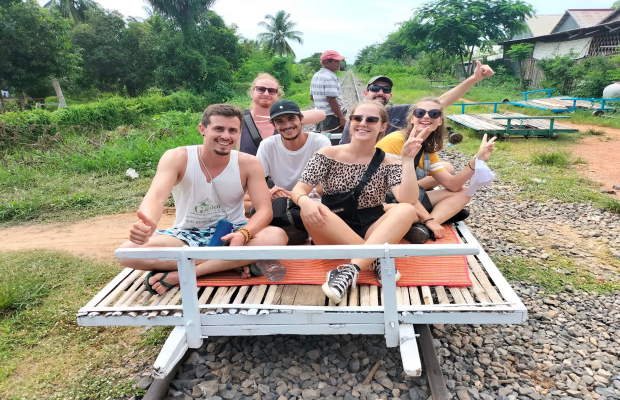


.jpg)
